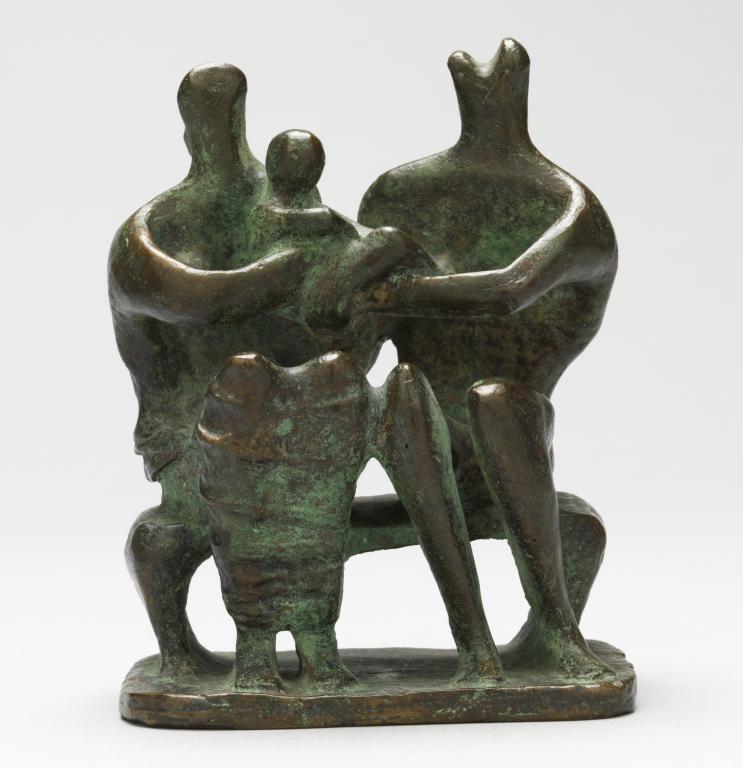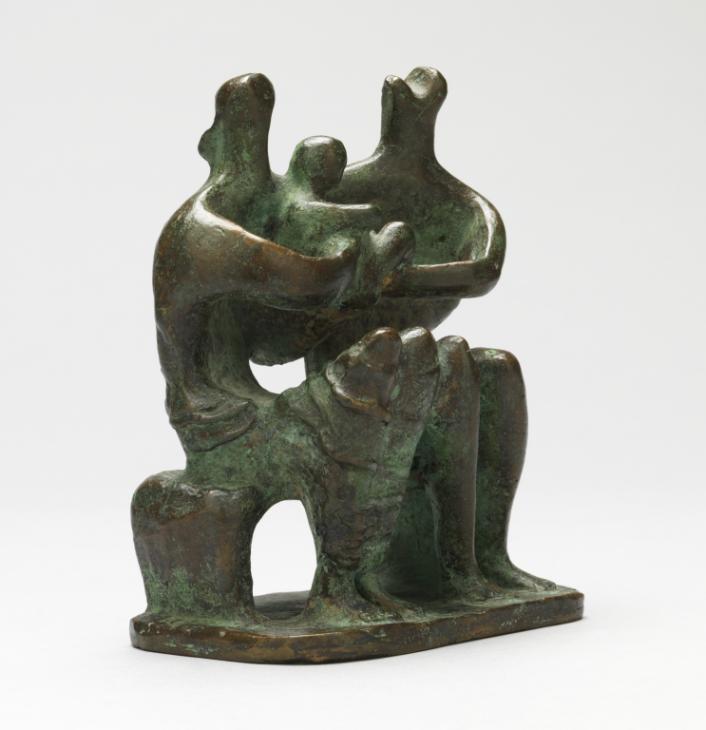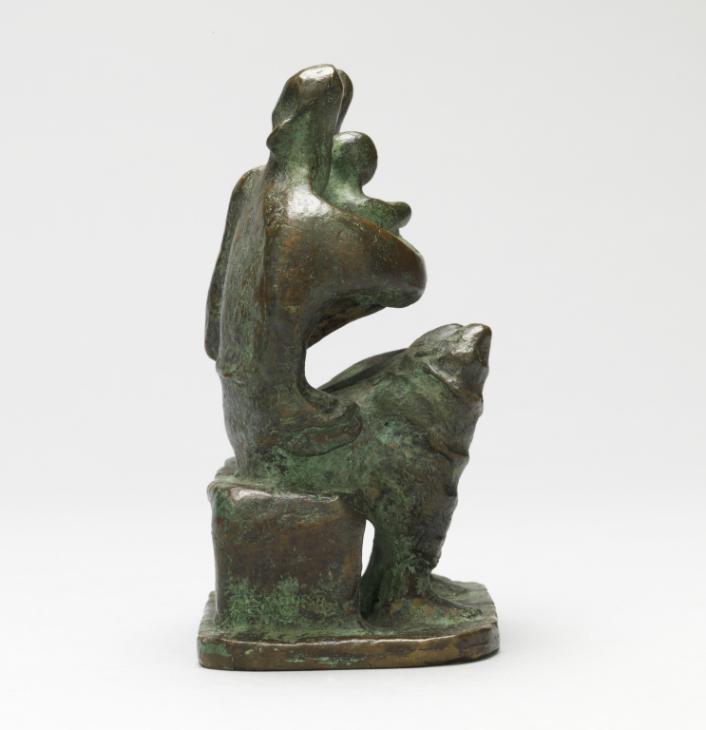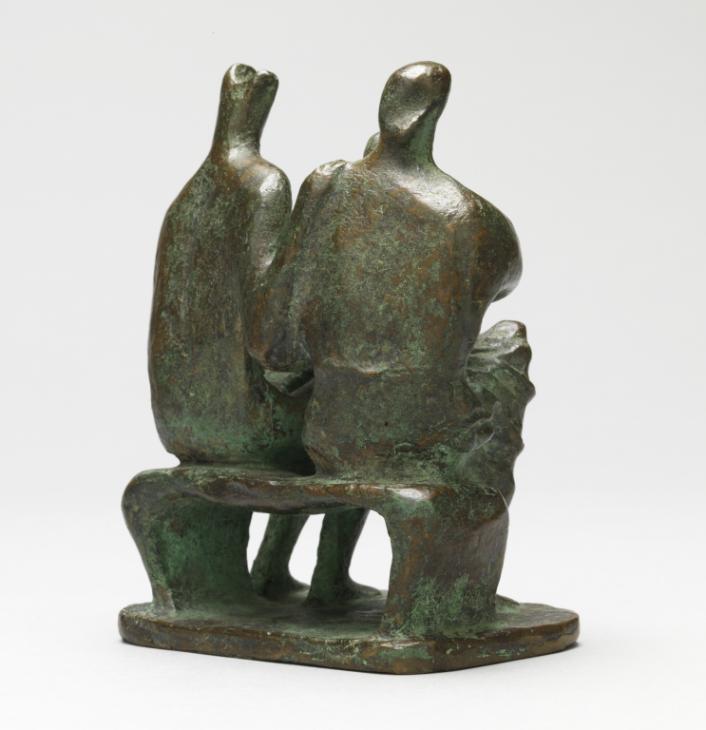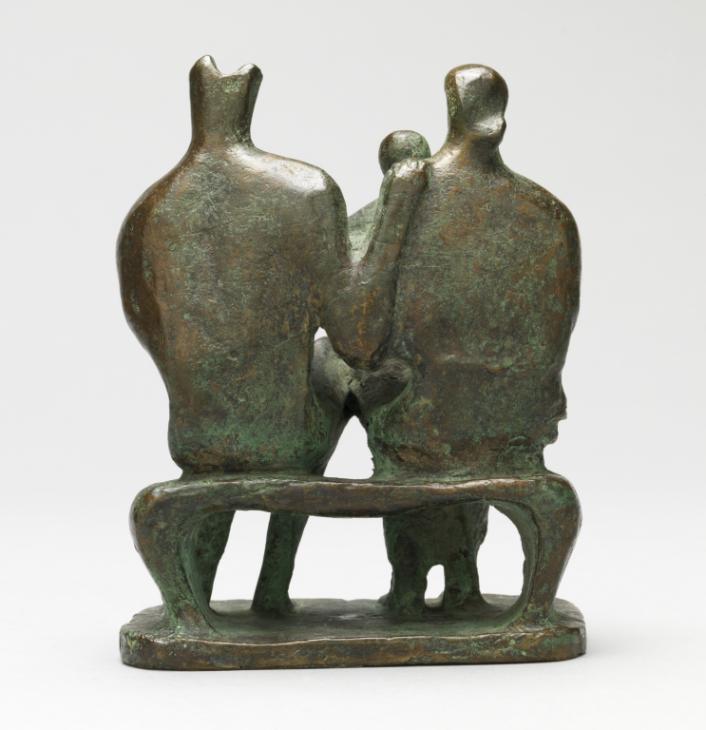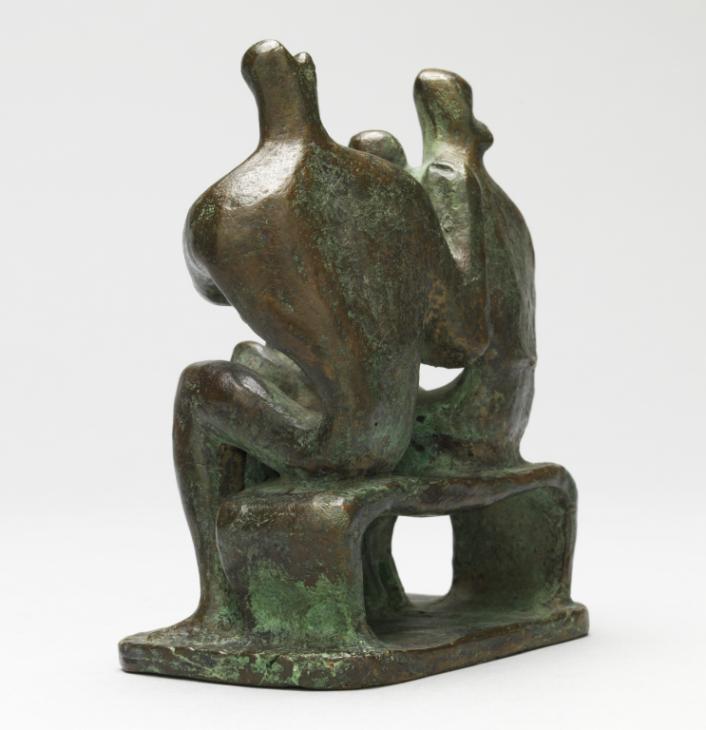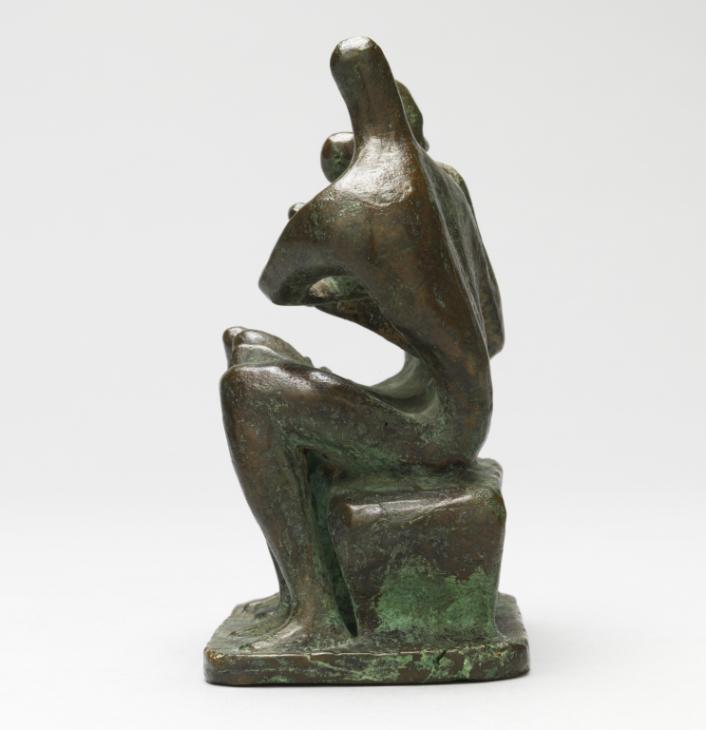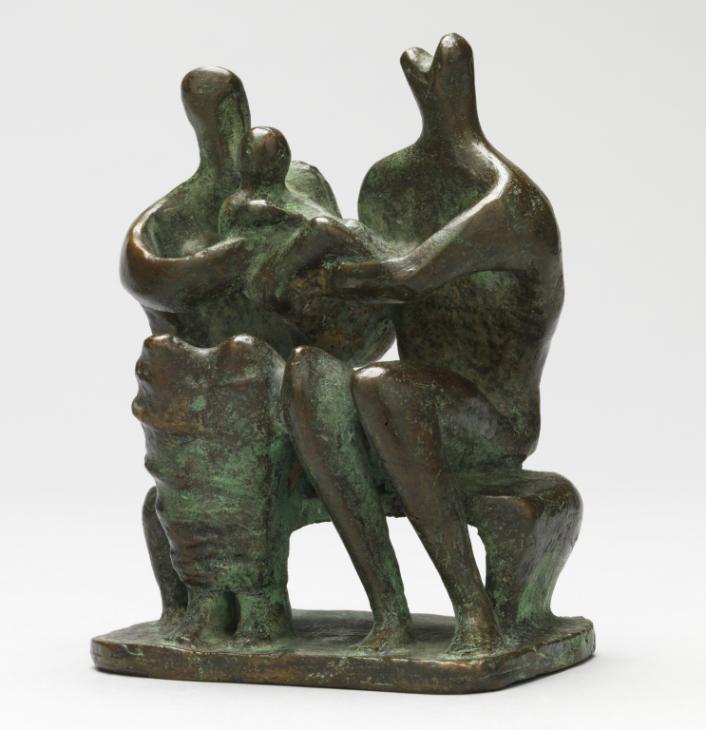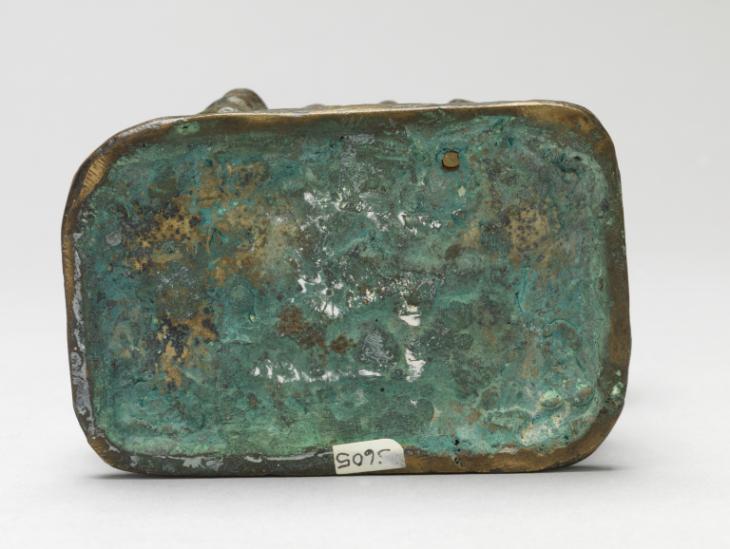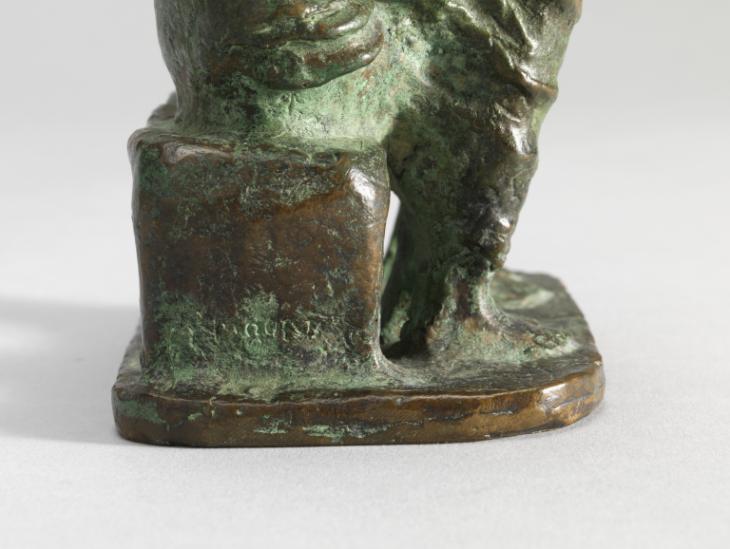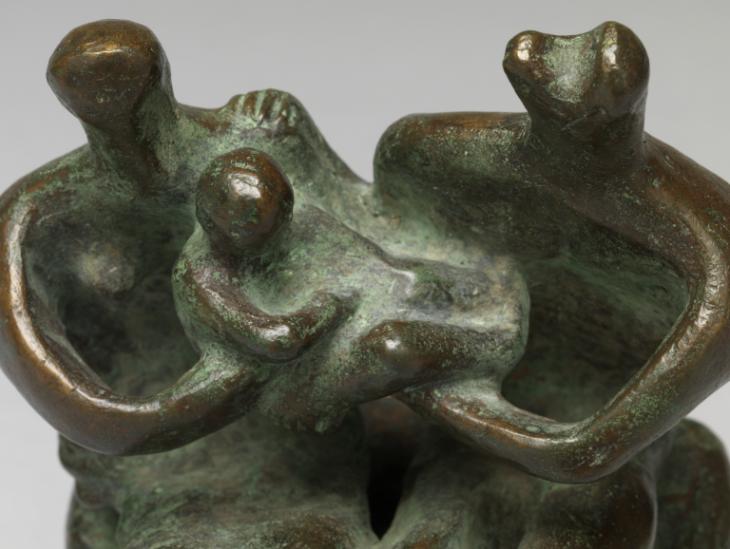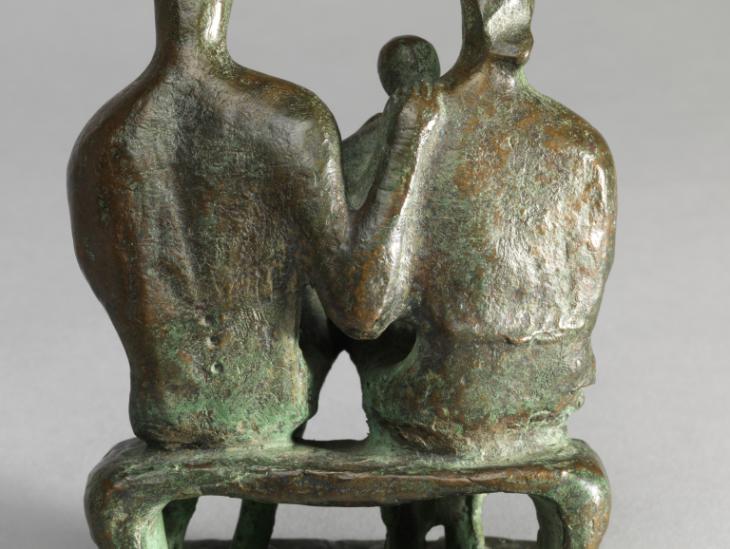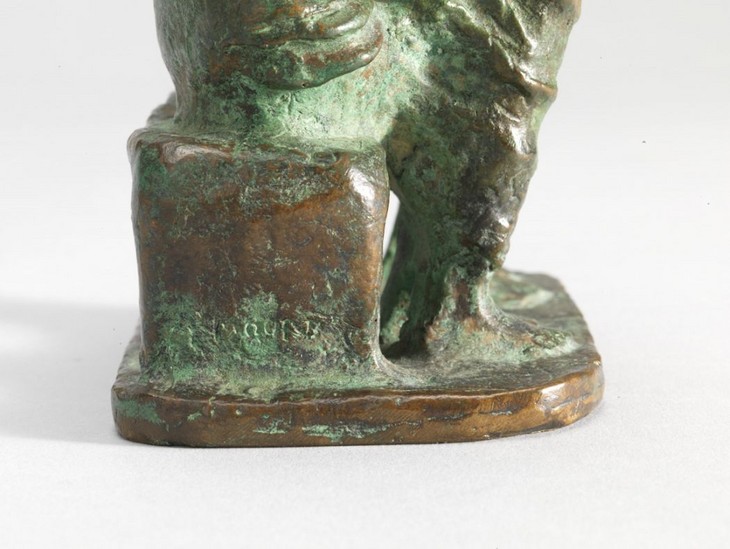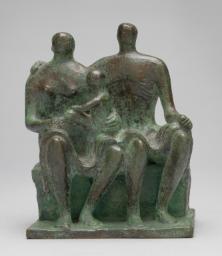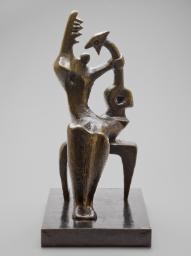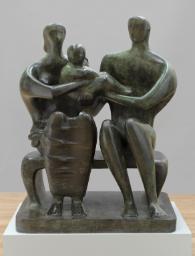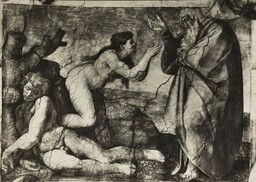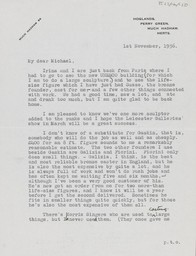Henry Moore OM, CH Maquette for Family Group 1945
Image 1 of 12
-
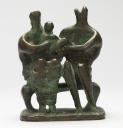 Henry Moore OM, CH, Maquette for Family Group 1945© The Henry Moore Foundation. All Rights Reserved© The Henry Moore Foundation. All Rights Reserved
Henry Moore OM, CH, Maquette for Family Group 1945© The Henry Moore Foundation. All Rights Reserved© The Henry Moore Foundation. All Rights Reserved -
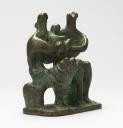 Henry Moore OM, CH, Maquette for Family Group 1945© The Henry Moore Foundation. All Rights Reserved© The Henry Moore Foundation. All Rights Reserved
Henry Moore OM, CH, Maquette for Family Group 1945© The Henry Moore Foundation. All Rights Reserved© The Henry Moore Foundation. All Rights Reserved -
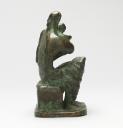 Henry Moore OM, CH, Maquette for Family Group 1945© The Henry Moore Foundation. All Rights Reserved© The Henry Moore Foundation. All Rights Reserved
Henry Moore OM, CH, Maquette for Family Group 1945© The Henry Moore Foundation. All Rights Reserved© The Henry Moore Foundation. All Rights Reserved -
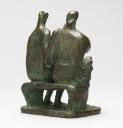 Henry Moore OM, CH, Maquette for Family Group 1945© The Henry Moore Foundation. All Rights Reserved© The Henry Moore Foundation. All Rights Reserved
Henry Moore OM, CH, Maquette for Family Group 1945© The Henry Moore Foundation. All Rights Reserved© The Henry Moore Foundation. All Rights Reserved -
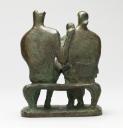 Henry Moore OM, CH, Maquette for Family Group 1945© The Henry Moore Foundation. All Rights Reserved© The Henry Moore Foundation. All Rights Reserved
Henry Moore OM, CH, Maquette for Family Group 1945© The Henry Moore Foundation. All Rights Reserved© The Henry Moore Foundation. All Rights Reserved -
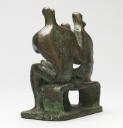 Henry Moore OM, CH, Maquette for Family Group 1945© The Henry Moore Foundation. All Rights Reserved© The Henry Moore Foundation. All Rights Reserved
Henry Moore OM, CH, Maquette for Family Group 1945© The Henry Moore Foundation. All Rights Reserved© The Henry Moore Foundation. All Rights Reserved -
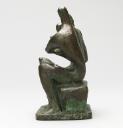 Henry Moore OM, CH, Maquette for Family Group 1945© The Henry Moore Foundation. All Rights Reserved© The Henry Moore Foundation. All Rights Reserved
Henry Moore OM, CH, Maquette for Family Group 1945© The Henry Moore Foundation. All Rights Reserved© The Henry Moore Foundation. All Rights Reserved -
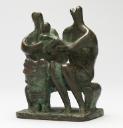 Henry Moore OM, CH, Maquette for Family Group 1945© The Henry Moore Foundation. All Rights Reserved© The Henry Moore Foundation. All Rights Reserved
Henry Moore OM, CH, Maquette for Family Group 1945© The Henry Moore Foundation. All Rights Reserved© The Henry Moore Foundation. All Rights Reserved -
 Henry Moore OM, CH, Maquette for Family Group 1945© The Henry Moore Foundation. All Rights Reserved© The Henry Moore Foundation. All Rights Reserved
Henry Moore OM, CH, Maquette for Family Group 1945© The Henry Moore Foundation. All Rights Reserved© The Henry Moore Foundation. All Rights Reserved -
 Henry Moore OM, CH, Maquette for Family Group 1945© The Henry Moore Foundation. All Rights Reserved© The Henry Moore Foundation. All Rights Reserved
Henry Moore OM, CH, Maquette for Family Group 1945© The Henry Moore Foundation. All Rights Reserved© The Henry Moore Foundation. All Rights Reserved -
 Henry Moore OM, CH, Maquette for Family Group 1945© The Henry Moore Foundation. All Rights Reserved© The Henry Moore Foundation. All Rights Reserved
Henry Moore OM, CH, Maquette for Family Group 1945© The Henry Moore Foundation. All Rights Reserved© The Henry Moore Foundation. All Rights Reserved -
 Henry Moore OM, CH, Maquette for Family Group 1945© The Henry Moore Foundation. All Rights Reserved© The Henry Moore Foundation. All Rights Reserved
Henry Moore OM, CH, Maquette for Family Group 1945© The Henry Moore Foundation. All Rights Reserved© The Henry Moore Foundation. All Rights Reserved
© The Henry Moore Foundation. All Rights Reserved
Henry Moore OM, CH,
Maquette for Family Group
1945
© The Henry Moore Foundation. All Rights Reserved
This sculpture is the small maquette for the larger Family Group 1949 (Tate N06004), the first work by Moore to have been designed specifically to be cast in bronze. During the mid-1940s Moore made numerous drawings presenting the family group in different arrangements, and this maquette was developed from these initial sketches.
Henry Moore OM, CH 1898–1986
Maquette for Family Group
1945
Bronze
127 x 98 x 63 mm
Inscribed ‘MOORE’ on leg of bench
Purchased from the artist through the Berkeley Galleries (Knapping Fund) 1945
In an edition of 7 plus 1 artist’s copy
N05605
Maquette for Family Group
1945
Bronze
127 x 98 x 63 mm
Inscribed ‘MOORE’ on leg of bench
Purchased from the artist through the Berkeley Galleries (Knapping Fund) 1945
In an edition of 7 plus 1 artist’s copy
N05605
Ownership history
Purchased from the artist through the Berkeley Galleries (Knapping Fund) in 1945.
Exhibition history
1945
Henry Moore: Sculpture and Drawings, Berkeley Galleries, London, March–April 1945, no.6.
1972
Painting, Sculpture and Drawing in Britain 1940–49, Whitechapel Art Gallery, London, November 1972.
1978
The Henry Moore Gift, Tate Gallery, London, June–August 1978, no number.
1990–1
Henry Moore: Sketch-Models and Working-Models, Mead Gallery, University of Warwick Arts Centre, Coventry, May–June 1990; Huddersfield Art Gallery, Huddersfield, June–August 1990; Library Arts Centre, Wrexham, August–October 1990; Bristol Museum and Art Gallery, Bristol, October–November 1990; Towner Art Gallery, Eastbourne, December 1990–January 1991; Royal Albert Memorial Museum, Exeter, January–March 1991; Smith Art Gallery, Sterling, March–April 1991, no.9.
1998
Special Exhibitions: Henry Moore, Imperial War Museum, London, September–November 1998.
2005
Henry Moore y México, Museo Dolores Olmedo, Mexico City, June–October 2005, no.33.
References
1945
Henry Moore: Sculpture and Drawings, exhibition catalogue, Berkeley Galleries, London 1945 (terracotta reproduced no.6).
1946
James Johnson Sweeney, Henry Moore, exhibition catalogue, Museum of Modern Art, New York 1946 (terracotta reproduced p.89).
1948
David Sylvester, ‘The Evolution of Henry Moore’s Sculpture II’, Burlington Magazine, vol.90, no.544, July 1948, p.193.
1957
David Sylvester (ed.), Henry Moore. Volume 1: Complete Sculpture 1921–48, London 1957, p.15, no.239 (reproduced p.151).
1963
Henry Moore, exhibition catalogue, Art Center, La Jolla 1963 (another cast reproduced no.45).
1966
Henry Moore, exhibition catalogue, Slovak National Gallery, Bratislava 1966 (another cast reproduced no.10).
1972
Mostra di Henry Moore, exhibition catalogue, Forte di Belvedere, Florence 1972 (another cast reproduced p.140).
1972
Painting, Sculpture and Drawing in Britain 1940–49, exhibition catalogue, Whitechapel Art Gallery, London 1972.
1978
The Henry Moore Gift, exhibition catalogue, Tate Gallery, London 1978, reproduced p.24.
1987
Henry Moore in India, exhibition catalogue, National Gallery of Modern Art, New Delhi 1987 (another cast reproduced no.41).
1999
Patrick McCaughey, Henry Moore and the Heroic: A Centenary Tribute, exhibition catalogue, Yale Center for British Art, New Haven 1999 (another cast reproduced).
2005
Henry Moore y México, exhibition catalogue, Museo Dolores Olmedo, Mexico City 2005, reproduced p.63.
Technique and condition
This maquette of a seated man and woman with a child is a solid bronze cast with no hollow cavity. The original model for this sculpture was made in clay and would have been used to make a mould from which the final bronze version could be cast. Moore made small impressions into the clay model to denote facial features, fingers and depressions at the base of the man’s spine that are replicated in the bronze sculpture. The level of surface detail on the bronze suggests that it was made using the traditional lost wax casting technique. Apart from the casting seams visible on the woman’s outer left leg and the man’s right hip, there is otherwise little evidence of post-cast finishing.
The bronze surface has been coloured using chemical patination techniques. First, a slightly transparent brown colour was applied over the surface, followed by a more opaque green colour, which was then rubbed back on high points using a light abrasive to pick out the details of the form. The patina was then finished with a coating of wax. The brown base colour is often used on bronzes and is likely to have been applied using a solution of potassium polysulphide (otherwise known as ‘liver of sulphur’) in water. There are many different patina recipes used to produce green colours on bronzes but they often contain mixtures of copper and ammonium salts.
The signature ‘MOORE’ was inscribed on the leg of the bench below the mother using a sharp point, possibly into the clay model or the pre-cast wax (fig.1). The maquette is in good condition.
Lyndsey Morgan
March 2011
How to cite
Lyndsey Morgan, 'Technique and Condition', March 2011, in Alice Correia, ‘Maquette for Family Group 1945 by Henry Moore OM, CH’, catalogue entry, March 2014, in Henry Moore: Sculptural Process and Public Identity, Tate Research Publication, 2015, https://wwwEntry
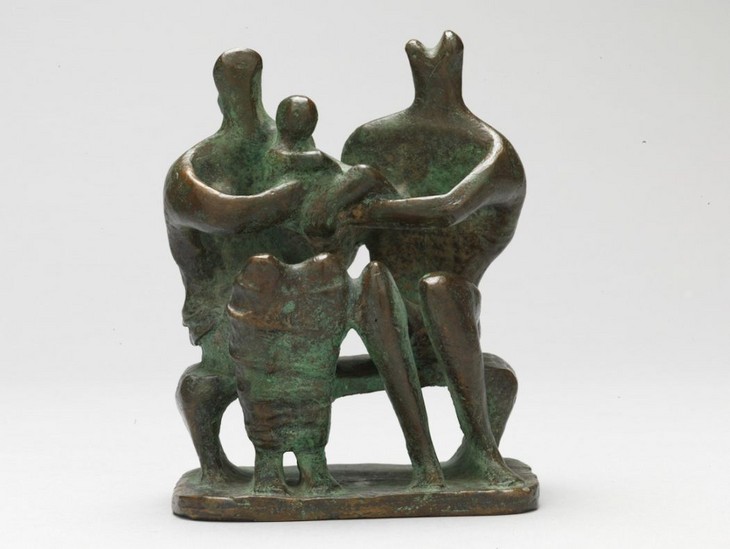
Henry Moore
Maquette for Family Group 1945
Tate N05605
© The Henry Moore Foundation. All Rights Reserved
Fig.1
Henry Moore
Maquette for Family Group 1945
Tate N05605
© The Henry Moore Foundation. All Rights Reserved
Maquette for Family Group depicts a man and woman seated on a low bench holding a small child between them. The woman sits to the man’s right and although she holds the bulk of the child, the man’s left arm supports the child’s legs while his right hand rests on the woman’s left shoulder (fig.1). The heads of the mother and child are spherical in shape, whereas the father’s head has been cleaved in two, and appears to represent an open mouth facing upwards. Other details also serve to differentiate the adults. The woman has small domed breasts and wears an ankle length skirt that drapes between her knees and stretches across the gap between her shins. Her legs are positioned straight out in front of her, while the man’s thin, tubular legs are positioned at a slight angle, orientated towards the woman. Unlike the woman, the man does not appear to be wearing any clothing on his lower body. Despite these differences, the poses of the two adult figures seem to mirror each other, especially in the way that the woman’s right arm and the man’s left arm both curve outwards from their shoulders in a similar arc to hold the child between them.
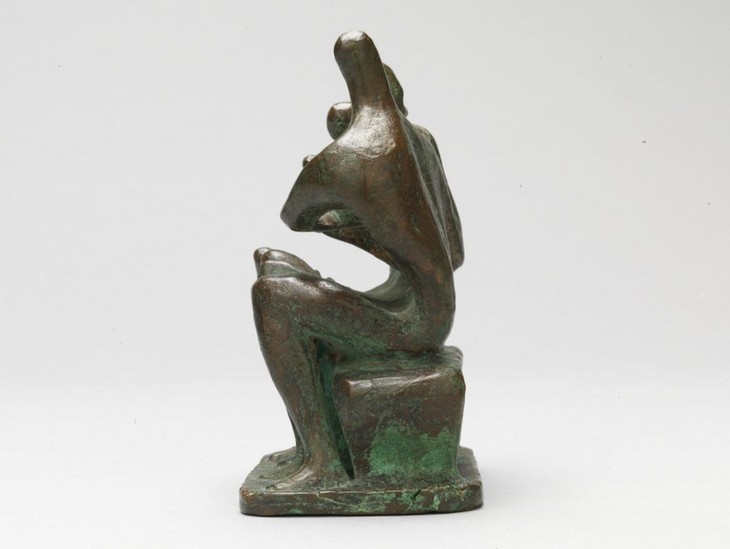
Henry Moore
Maquette for Family Group 1945 (side view)
Tate N05605
© The Henry Moore Foundation. All Rights Reserved
Fig.2
Henry Moore
Maquette for Family Group 1945 (side view)
Tate N05605
© The Henry Moore Foundation. All Rights Reserved
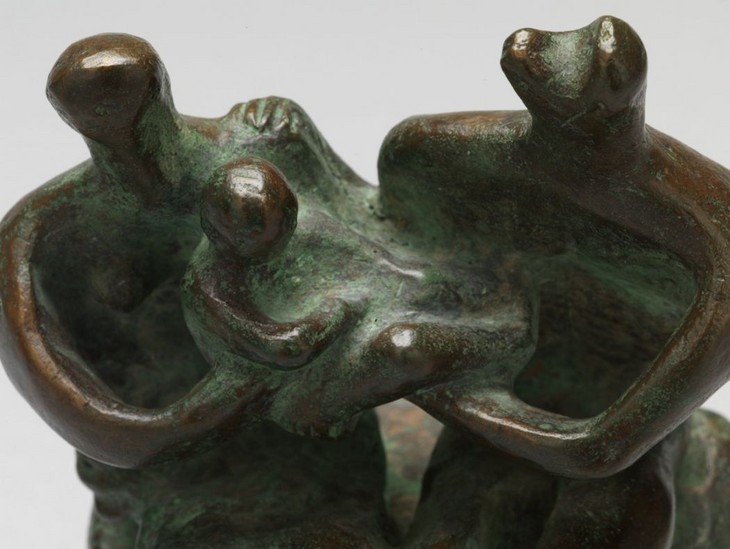
Detail of child in Maquette for Family Group 1945
Tate N05605
© The Henry Moore Foundation. All Rights Reserved
Fig.3
Detail of child in Maquette for Family Group 1945
Tate N05605
© The Henry Moore Foundation. All Rights Reserved
When viewed from the side it becomes apparent that the sculpture is not very deep (fig.2). The figures’ knees are drawn up so that their bodies appear to be folding inwards, and their torsos are unnaturally thin. In contrast, the child is chubby and rounded (fig.3). Positioned in the middle of the sculpture and held aloft by its parents, the child is the natural focal point. Discussing the arrangement of the figures, Moore identified how ‘the arms of the mother and the father [intertwine] with the child forming a knot between them, tying the three into a family unity’.1
Maquette for Family Group is one of at least fourteen small models made by Henry Moore in the mid-1940s, each of which presents a family group in different poses and configurations. The origins of these sculptures lie in the mid-1930s, when the German architect Walter Gropius proposed to Moore that he make a large-scale sculpture for a school in Impington, near Cambridge, which was designed by Gropius and Maxwell Fry in 1935–6 and opened in 1939. The college was designed to be a flexible space that catered for all the family, acting as the focal point for the entire community.2 Moore later recalled discussing the commission with Henry Morris, Chief Education Officer for Cambridgeshire County Council:
we talked and discussed it, and I think from that time dates my idea for the family as a subject for sculpture. Instead of just building a school, he was going to make a centre for the whole life of the surrounding villages, and we hit upon this idea of the family being the unit that we were aiming at.3
In 1951 Moore wrote that,
later the war came and I heard no more about it until, about 1944, Henry Morris told me that he now thought he could get enough money together for the sculpture if I would still like to think of doing it. I said yes, because the idea right from the start had appealed to me and I began drawings in note book form of family groups. From these note book drawings I made a number of small maquettes, a dozen or more.4
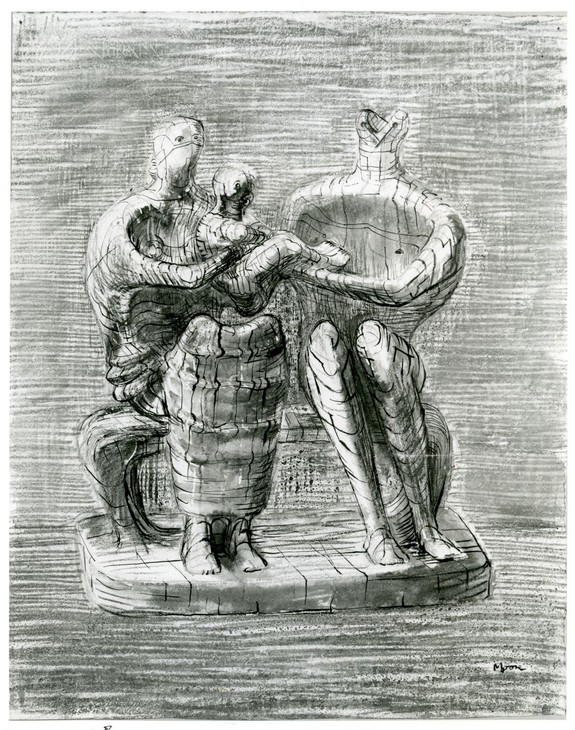
Henry Moore
Family Group 1945
Graphite, wax crayon, coloured crayon, watercolour wash, pen and ink on paper
490 x 390 mm
© The Henry Moore Foundation. All Rights Reserved
Photo: Henry Moore Foundation Archive
Fig.4
Henry Moore
Family Group 1945
© The Henry Moore Foundation. All Rights Reserved
Photo: Henry Moore Foundation Archive
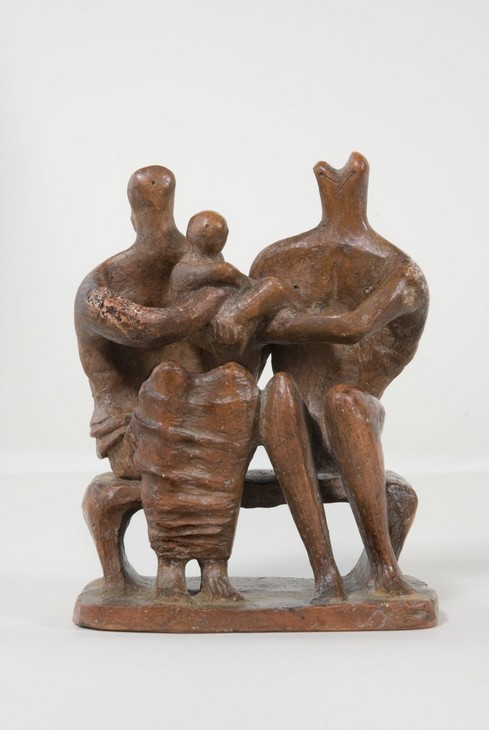
Henry Moore
Maquette for Family Group 1945
Terracotta
The Henry Moore Foundation
© The Henry Moore Foundation. All Rights Reserved
Photo: Michael Phipps, Henry Moore Foundation Archive
Fig.5
Henry Moore
Maquette for Family Group 1945
The Henry Moore Foundation
© The Henry Moore Foundation. All Rights Reserved
Photo: Michael Phipps, Henry Moore Foundation Archive
Maquette for Family Group was cast at the Art Bronze Foundry, London, in an edition of seven plus one artist’s copy. Notes made by Moore for the owner of the foundry, dated ‘March 28’, identify three Family Group maquettes for casting, along with five maquettes for Moore’s Madonna and Child, which date from 1943.8 The inclusion of this Maquette for Family Group suggests that Moore made these casting notes in 1945. It is number five on the list, and a small sketch of the work is annotated with the phrase ‘Man with split head | + child held between man + woman’. The notes indicate that seven bronze examples were wanted, and that two examples of this particular maquette had been cast and delivered to an unnamed gallery by 28 March. It is likely that the gallery mentioned on the note was the Berkeley Galleries, London, where Moore had an exhibition in March–April 1945.
In 1994 Bernard Meadows, who was Moore’s studio assistant at the time the maquettes were cast, recalled that after they were returned to Moore from the foundry they required a lot of finishing work:
He [Moore] wasn’t very satisfied with Gaskin’s casts [Charles Gaskin was the owner of the Art Bronze Foundry]. They were pretty rough, they were pretty bad and some of them, I said to him, ‘well you ought not accept that’. But he went ahead, he was half worried about upsetting any of these foundry chaps because where would he get them cast here in Britain? ... they were in such a state that one had to get them back to some semblance of acceptability ... the bronzes had to be worked on and then they had to go back to the foundry to be patinated.9
In an article published in the Burlington Magazine in July 1948, Sylvester, who had worked as Moore’s personal assistant in 1945, noted that ‘Moore had always made maquettes for his larger sculptures, but it was not until he cast about half-a-dozen of the ten or so clay studies for the Northampton Madonna that he began to make bronzes of them’.10 The bronze maquettes of family groups were produced to be sold privately and were probably cast to provide an income in case the Impington commission failed to materialise. Moore’s decision to make multiple bronze casts drastically altered the type of work he was able to produce, and provided more opportunities to sell his work. Meadows later recalled that ‘most of these little family groups were sold for £35 (having cost about £12 to cast) so he [was] making just over £20 per sculpture’.11
Sylvester also suggested that this particular maquette was ‘notable for the conviction of the movement with which the child is passed from one parent to the other and for the successful rendering of a sense of both volume and lightness in the child’.12 However, he went on to claim that ‘there is a painful inconsistency ... between the style of the stirrup-like torso of the father and hollow gourd-like torso of the mother, on the one hand, and the overgeneralised naturalism’ of the child.13 Nonetheless, the sculpture was quickly championed as one of Moore’s most significant works. In 1948 the art and film theorist Rudolf Arnheim discussed Family Group in light of Moore’s earlier use of holes in his sculptures. He noted that in earlier works, such as Recumbent Figure 1938 (Tate N05387), Moore pierced the body with holes to create spatial ambiguity, but that Family Group achieved similar effects without the use of holes. Arnheim argued that, ‘in Moore’s family group, hollow abdomens make the two seated figures into one large lap or pocket. In this shadowed cavity, space appears tangible, stagnant, warmed by body heat. In its center, the suspended infant lies safely as though contained in a womb softly padded with half-solid air’.14
Moore and the Tate Collection
This sculpture was one of three bronze family group maquettes bought by Tate in 1945 and is thus one of the earliest works by Moore to have been purchased for the Tate collection. The purchase of these works illustrated the desire of the director Sir John Rothenstein to represent Moore’s work in the collection. In contrast, Rothenstein’s predecessor, J.B. Manson, had previously told the Tate trustee Robert Sainsbury ‘over my dead body will Henry Moore ever enter the Tate’.15 Rothenstein’s appointment thus signalled a shift in the direction of Tate’s ambitions. One of his first actions as director had been to accept the donation from the Contemporary Art Society of Moore’s Recumbent Figure 1938 (Tate N05387). Then in 1941 Rothenstein encouraged the appointment of Moore to Tate’s Board of Trustees.
In 1944 Rothenstein wrote to Moore asking whether Tate could commission a large carving based on one of his Madonna and Child maquettes (see Tate N05602). Moore politely turned down the suggestion, writing ‘its now more than a year since these little figure studies were done, + that’s whats [sic] making me hesitate now over your suggestion – for it would mean putting my mind back in working to a year ago’.16 Instead, Moore suggested that the Tate might be interested in some of the studies for a ‘Family Group’ he had recently begun working on. This proposal was accepted and Tate bought four maquettes for the Madonna and Child and three maquettes for the Family Group.
The three maquettes for Family Group were purchased from the artist through the Berkeley Galleries in early 1945 with money from the Knapping Fund.17 The Knapping Fund was the residuary estate of Miss Helen Knapping bequeathed to the Trustees of the National Gallery in 1935 to be spent on work by living or recently deceased British artists. A fraction of this money was allocated to the Tate by the National Gallery, as Tate’s purchasing power continued to rely on charitable donations and private patronage until well after the Second World War.
As Moore suspected, Henry Morris was unable to secure financial backing and institutional support for the Impington commission. However, in 1947 Moore was approached by John Newsom, Director of Education in Hertfordshire, who enquired whether Moore would be interested in creating a new sculpture for Barclay Secondary School in Stevenage, Hertfordshire. This maquette was used as the template for the enlarged bronze sculpture, which was cast in an edition of four. In 1950 Tate acquired a full-size bronze example of Family Group 1949 (Tate N06004).
Alice Correia
March 2014
Acknowledgements
This catalogue entry was compiled from research undertaken by Robert Sutton, Collaborative Doctoral Award student (University of York and Tate).
This catalogue entry was compiled from research undertaken by Robert Sutton, Collaborative Doctoral Award student (University of York and Tate).
Notes
See Harry Rée, Educator Extraordinary: The Life and Achievement of Henry Morris, London 1973, pp.70–2.
Henry Moore cited in Farewell Night, Welcome Day, television programme, broadcast BBC, 4 January 1963, reprinted in Alan Wilkinson (ed.), Henry Moore: Writings and Conversations, Aldershot 2002, p.89.
Henry Moore in ‘Henry Moore Talking to David Sylvester’, 7 June 1963, transcript of Third Programme, broadcast BBC Radio, 14 July 1963, Tate Archive TGA 200816, p.13. (An edited version of this interview was published in the Listener, 29 August 1963, pp.305–7.)
See David Sylvester (ed.), Henry Moore. Volume 1: Complete Sculpture 1921–48, 1957, 5th edn, London 1988, pp.14–15.
David Sylvester, ‘The Evolution of Henry Moore’s Sculpture II’, Burlington Magazine, vol.90, no.544, July 1948, p.190.
Rudolf Arnheim, ‘The Holes of Henry Moore: On the Function of Space in Sculpture’, Journal of Aesthetics and Art Criticism, vol.7, no.1, September 1948, p.33.
Related essays
- Fashioning a Post-War Reputation: Henry Moore as a Civic Sculptor c.1943–58 Andrew Stephenson
- At the Heart of the Establishment: Henry Moore as Trustee Julia Kelly
- Henry Moore and the Welfare State Dawn Pereira
- Henry Moore's Approach to Bronze Lyndsey Morgan and Rozemarijn van der Molen
- ‘A sincere academic modern’: Clement Greenberg on Henry Moore Courtney J. Martin
- ‘Worthy of the great tradition’: Kenneth Clark on Henry Moore Chris Stephens
Related catalogue entries
Related material
Related bibliography
How to cite
Alice Correia, ‘Maquette for Family Group 1945 by Henry Moore OM, CH’, catalogue entry, March 2014, in Henry Moore: Sculptural Process and Public Identity, Tate Research Publication, 2015, https://www

